Note: this content was originally published as a five-part series in late 2017. I?ve been asked to consolidate the content into a single post. This is the original content, updates have not been introduced with this new publication.
?One day Alice came to a fork in the road and saw a Cheshire cat in a tree. ?Which road do I take?? she asked. ?Where do you want to go?? was his response. ?I don?t know,? Alice answered. ?Then,? said the cat, ?it doesn?t matter.?
Heard about Jobs to be Done?
Maybe you picked up Clay Christensen?s 2016 book ?Competing Against Luck? or you?ve seen the #jtbd hashtag on Twitter. You?re interested in this idea that ?customers want to make progress in their lives and they hire products to help them get that job done? and how it can help you make progress.
Unfortunately, this seemingly simple little theory has amassed a daytime-television-worthy level of intrigue and drama.

Little JTBD has (at least) two men who can lay claim to have originated the approach, and others who have raised it as their own and expect some credit too.
The irony of course is what the argument is over. Laying claim to the belief that:
Customers don?t care about your product. They care about what it helps them do.
The product in question? The ?right? approach to surfacing and applying JTBD insights.
As an innovation and strategy consultant, my goal is to help my clients consistently create winning products. I?m purposely methodology-agnostic. That being said, I see a lot of value in looking at problems through the ?Jobs to be Done? lens.
In this article, I?ll introduce the different flavors of JTBD and how to decide which is most appropriate to help you meet your innovation goals. My goal is to help others pick up on the nuances of these approaches so they can make focus on making progress on their own innovation journey.
 Approaches and People
Approaches and People
There are two generally accepted schools of thought when it comes to moving JTBD from theory to practice.
Strategyn?s Outcome-Driven-Innovation (ODI) Process
I first talked to Tony Ulwick about ODI in 2016. I said ?oh, so you took JTBD and made it actionable!? Tony was quick to let me know that ODI predated Christensen?s book ?The Innovator?s Solution?.
According to the Strategyn website, ODI ?starts with a deep understanding of the job the customer is trying to get done and the metrics they use to evaluate competing product and service offerings. These metrics, a special type of need statement we call desired outcomes, form the basis for our innovation process. By knowing how customers measure value, companies are able to align the actions of marketing, development, and R&D with these metrics and systematically create customer value.?
The Strategyn approach is? comprehensive. In his 2016 book ?Jobs to be Done: Theory to Practice?, Tony Ulwick lists out the 84-step process that his ODI Practitioners use in a client engagement. I?ve heard ODI described as a sledgehammer.
As may be obvious, this approach is very prescriptive. It involves both qualitative and quantitative research and leads to market and product strategy formulation. Sound great? All you consultants out there, don?t get too excited. ODI is a proprietary approach developed and practiced by Strategyn.
Rewired Group?s ?Switch Interviews?.
If you?ve ever seen an offer to ?learn how to run a JTBD interview?, you?re probably learning a technique developed by the Detroit-based Rewired Group. They hold in-person workshops and there?s also an online video training series to help people learn how to conduct Switch interviews.
According to the video course website, these interviews help aspiring entrepreneurs
- get to the real causality of why a consumer shops and buys,
- understand when to accept what a consumer is saying as fact, and when to challenge, and
- why consumer satisfaction is important, but it fails us when we?re developing new products.
The Switch interview training focuses on the gathering of insights, but does not include any discussion of how to interpret and apply the findings. As a result, it has become a fruitful starting point for a variety of different ways to interpret and apply findings.
Characters
Clayton Christensen, Harvard Business School professor and author published ?The Innovator?s Dilemma (1998),? ?The Innovator?s Solution (2003)? and ?Competing Against Luck (2016)?. These books introduced the concepts of disruptive innovation and Jobs Theory.
Tony Ulwick is the founder of Strategyn and the author of ?What Customers Want (2005)? and ?Jobs to be Done: Theory to Practice (2016)?. He explains how he introduced the Strategyn Outcome-Driven Innovation process to Christensen in the late ?90s as a way to solve the Innovator?s Dilemma in this blog post, which also features a fantastic video from 2000. Oh, that fashion style!
In ?the Innovator?s Solution,?, Christensen mentions Rick Pedi, the CEO at Gage Foods who coined the language ?job to be done?. In his most recent book ?Competing Against Luck?, Christensen retells the story of Rick Pedi and his partner Bob Moesta as consultants who were working in the baking industry and wished to learn more about disruptive innovation.
Bob Moesta and Chris Spiek founded the Rewired Group and you?ve probably heard them on JTBD Radio or the aforementioned Switch Interviews video.
Jay Haynes runs thrv, which is a Jobs to be Done Product Management Software platform, and also offers services & training. He?s also the former CEO of Strategyn, so the interface includes the Desired Outcome Statements that are uncovered during the ODI process.
(Updated Dec 2017) Alan Klement is the author of what he claims is the first book dedicated to Jobs to be Done (in 2016). As will be obvious over this series, this is simply not the truth.
Alan claims he has ?Evolved? JTBD Theory, and frequently tries to discredit others working in the field. While his perspective on customer progress is interesting, his claims are too much a departure from the original published material on JTBD for me to consider them a true evolution. Instead, Klement seems intent on re-writing history and claiming JTBD as his own, even frequently contradicting himself on Twitter. I may include some of his thoughts as a counter-point through this series, but anyone hoping to apply a Jobs to be Done lens to his work would be well-advised to look to established approaches, rather than this ?evolution-of-theory-in-progress.?
And look at what I?m doing, even now. I?m focusing too much on the ?products? and not enough on what they can help you do.
 Selling Jobs to be Done: Who?s the Customer?
Selling Jobs to be Done: Who?s the Customer?
The Jobs to be Done theory ? that ?customers want to make progress in their lives and they hire products to help them get that job done? ? can revolutionize a company. Rather than focusing on how to compete in a feature war against other competitors based on ?industry standards?, you have the ability to break away as a result of unique customer insights.
But great potential can lead to great confusion.
Customer insights can ripple across an organization, and be interpreted differently by different parties. That?s why understanding the context and circumstance that leads to JTBD research is so important.
Over the past few weeks, I?ve talked about JTBD with three prospects. Each came to me already thinking JTBD could solve a problem in their business.
But each had a different problem to be solved; a different Job to be Done.
Each wanted to learn about their customers? Jobs, but held a different vision of the progress they were trying to make.
- Change how sales and marketing communicate value to our prospects so we can close more deals faster (Digital Marketing Manager)
- Improve the product for our customers so they will churn less (UX Director)
- Cultivate a shared understanding of our customer across the organization so we are more effective in creating and selling products (CEO)
- Identify adjacent areas where our customers are dissatisfied to introduce new products to our portfolio so we can improve our ARPU and stickiness (Intrapreneur)
Not only did each of these customers have a different view of the progress they were trying to make, each one had a different target object he planned to act on. Sales and marketing will change. The product will change. The entire organization will change. Our product portfolio will change.
Remember, Jobs to be Done is just a theory about how any why customers and ?hire? products into their lives. Even as you learn about and accept the theory, how it?s applied to your organization to meet your specific goals will be unique to you.
If you?re part of a team eager to bring Jobs to be Done into your organization, great! You can (hopefully) see how understanding your customers? progress and struggles can transform your business, and what target objects you have to work with.
If you?re a consultant, things may be a little less clear for you. You?re staring down the eye of a powerful weapon, and not sure yet how you want to use it. That?s ok, too. Just be aware that you?re going to be much more successful if you take the time to figure out where you want to shoot it before you pull the trigger with a client 🙂
Now we have much more information about the customer, his desired progress, and the target object he plans to act on. Soon we can start digging into his struggles and identify a way to move him forward. But first, we need to Define the ?Job? in Jobs to be Done [Pt 3].
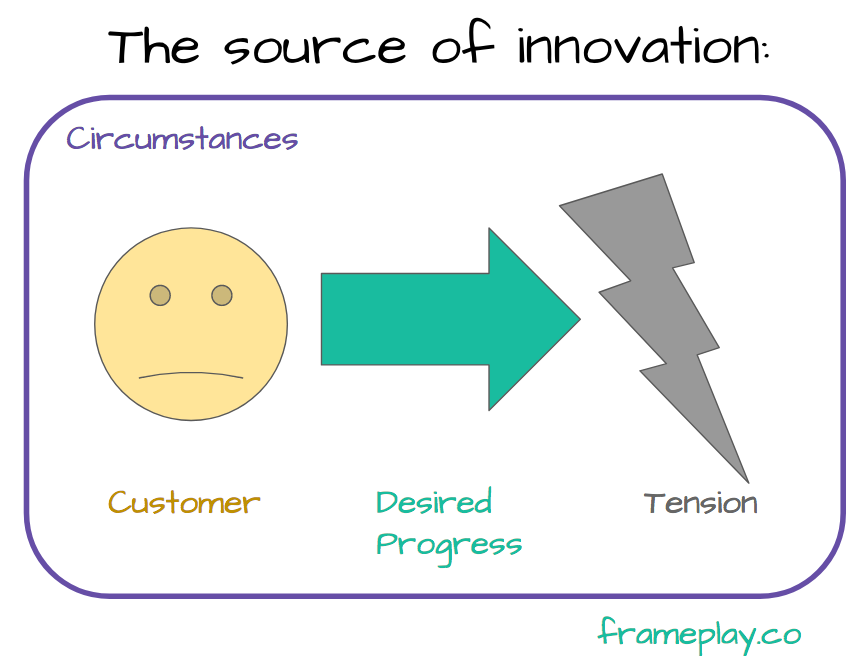
 Defining the ?Job? in Jobs to be Done
Defining the ?Job? in Jobs to be Done
If you want to apply your understanding of your customers Jobs to be Done to create impactful products and services, you need to know what Jobs are in question. Seems simple, but right off the bat there are some differences in terminology.
Peter Drucker (Innovation and Entrepreneurship, 1985)
- Process need, unlike the other sources of innovation, does not start out with an event in the environment, whether internal or external. It starts out with the job to be done.
- It is task-focused rather than situation-focused. It perfects a process that already exists, replaces a link that is weak, redesigns an existing old process around newly available knowledge.
Clay Christensen (The Innovator?s Solution, 2003)
- Customers ? people and companies ? have ?jobs? that arise regularly and need to get done.
- When customers become aware of a job that they need to get done in their lives, they look around for a product or service they can ?hire? to get the job done
- Their thought processes originate with an awareness of needing to get something done, and then they set out to hire something or someone to do the job as effectively, conveniently and inexpensively as possible.
- The functional, emotional and social dimensions of the jobs that customers need to get done constitute the circumstances that they buy.
- The jobs that customers are trying to get done or the outcomes that they are trying to achieve constitute a circumstance-based categorization of markets.
- Companies that target their products at the circumstances in which customers find themselves, rather than at the customers themselves, are those that can launch predictably successful products. Put another way, the critical unit of analysis is the circumstance, and not the customer.
Tony Ulwick (What Customers Want, 2005)
- There are three different types of jobs that customers are often trying to get done in a given circumstance: functional jobs and personal and social jobs (two types of emotional jobs).
- Functional jobs define the tasks people seek to accomplish, personal jobs explain the way people want to feel in a given circumstance, and social jobs clarify how people want to be perceived by others.
Clay Christensen (Article: Finding the Right Job for Your Product, 2007)
- A job is the fundamental problem a customer needs to resolve in a given situation.
- Products don?t engender emotions. Situations do.
- To provide the complete set of functional, emotional and social experiences in purchase and use that will sum up to nailing the job perfectly, the situation ? rather than the customer ? must be the fundamental unit of marketing analysis.
Tony Ulwick (Jobs to be Done: Theory to Practice, 2016)
- People buy products and services to get a job done. The job the end user is trying to get done is the core functional job.
- The core functional job is the anchor around which all other needs are defined. It is defined first, then the emotional, related and consumption chain jobs are defined relative to the core functional job.
- Leave emotional and other needs out of it. When defining the core functional job make sure it is defined as a functional job, not as a hybrid functional/emotional/social job. A functional job does not have social and emotional dimensions. The emotional and social jobs related to the core functional job are defined in a series of separate emotional job statements.
- A job is stable; it doesn?t change over time
- A job has no geographic boundaries
- A job is solution agnostic
Clay Christensen (Competing Against Luck, 2016)
- A job is the progress that an individual seeks in a given circumstance
- Jobs are never simply about the functional ? they have important social and emotional dimensions, which can be even more powerful than functional ones
- Jobs to be Done are ongoing and recurring. They?re seldom discrete ?events?
Jim Kalbach (Mapping Experiences, 2016)
- The concept of Jobs to be Done provides a lens through which to understand value creation.
- The framework looks at customer motivations in business settings.
- Jobs to be done are ultimately about an underlying need and desired outcomes.
- Viewing value creation in this way shifts focus from the psycho-demographic aspects of individuals to their goals and motivations. It?s not about the user but about usage.
- The context of the job is critical to understand.
- Jobs to be done is an existing framework that helps view value from an individual?s standpoint. The practice looks at why people ?hire? products and services to reach a desired outcome.
Jim Kalbach (Article: A Practical Model for Jobs To Be Done (JTBD), 2016)
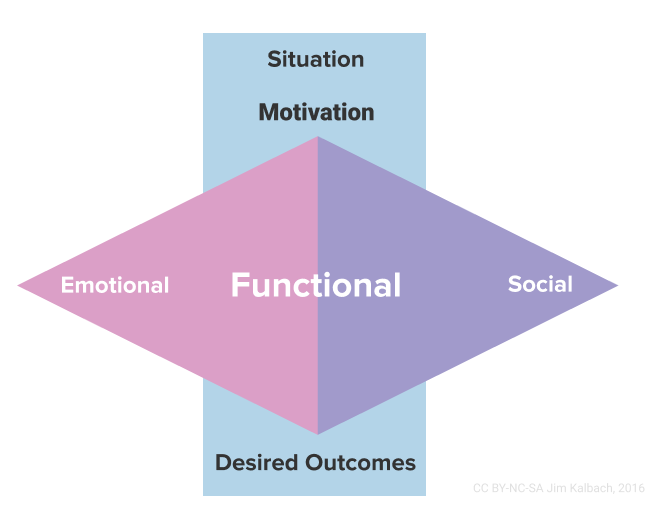
- Typically, a JTBD is expressed in terms of its functional job. Because of this some people have the misconception that JTBD is the same as task analysis.
- The context of the job is also part of the model. (Situation, Motivation and Desired Outcomes)
- Jobs theory sees people as goal-driven actors.
- The job is really about progress toward a goal.
- The JTBD approach shows causality ? why they behave the way they do.
- Jobs to be Done can be used to 1. Understand the Market, 2. Design for the Market, 3. Talk to the Market, 4. (Re)define Markets.
Alan Klement* (When Coffee and Kale Compete, 2016)
- A Job is one?s emotional struggle to make life better.
- It?s Done when one finds the right solution to overcome that struggle and make that better life happen.
- A JTBD is purely emotional. Tasks, activities, or functionality describes solutions for Jobs.
Updated Dec 2017: Klement?s definition of a #JTBD is now tied to purchase behavior. He has recently stated that he is solely interested in researching customer demand, and it?s up to others to drive strategy and make decisions.
- A Job to be Done is the process a consumer goes through whenever she aims to transform her existing life-situation into a preferred one, but cannot because constraints are stopping her
- A JTBD should describe demand only ? why consumers would want to consumer (sp) a product, service or technology
- Most product purchases are not to fulfill a JTBD
- If I?m buying and using the same types of products I?ve always used, I?m executing habits.
- If I?m executing a habit, I?m not interested in progress. I have no JTBD.
- ?Get from A to B? is not a JTBD.
- A JTBD explains why I changed my historical use of the market. I used to own a car but then I switched to Uber. Why? I desired change.
? This is a stark departure from any previous interpretation of Jobs to be Done. In the opinion of this author, this is not an ?evolution of Jobs Theory?. This does not help aspiring innovators create better products/services. It?s included here for completeness, but not recommended.
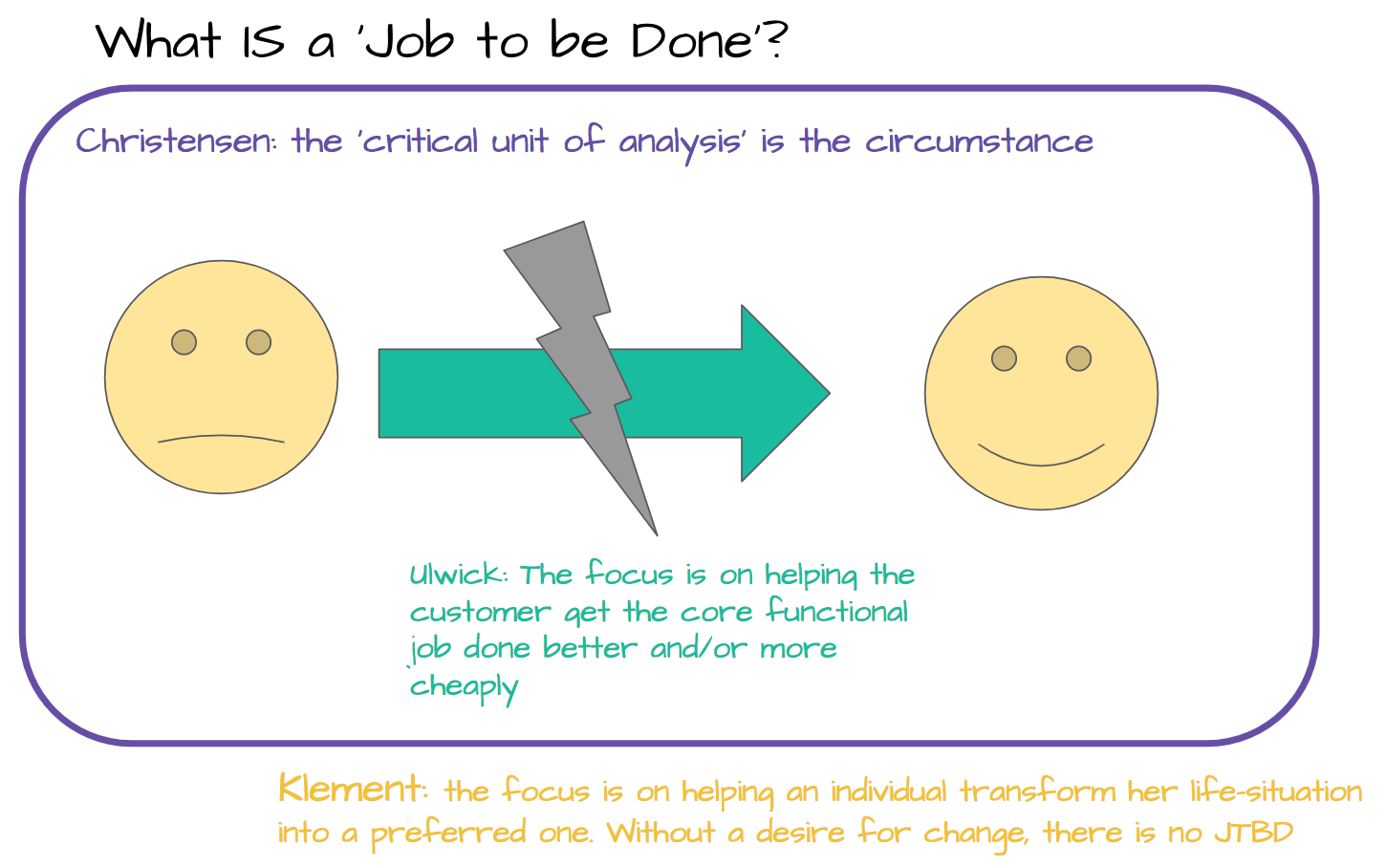
If you?re looking to hand over your JTBD research to your product and engineering teams to execute on, you?re going to get some pushback if you walk in with a description of a customers? emotional struggle. If you show up with some direction of how the product should be improved to help the user, they can dive right in.
There?s a lot of literature on Jobs to be Done. Keep in mind the progress you and your team are trying to make before you hire one approach or another. And now, onto the struggle!
 The Struggle and the Opportunity!
The Struggle and the Opportunity!
Jobs to be Done is about a customer making progress towards a desired future.
In order to innovate, we want to understand not only the progress the customer is trying to make towards a desired future, but also the challenges he?s facing in his journey.
Here too the Jobs to be Done community have a few different ways they interpret these concepts.
Identifying the Struggle
Desired Outcome Statements
In the Outcome-Driven Innovation process (that focuses on core functional jobs), it?s believed that ?customers know perfectly well how they measure success when executing a job and are very capable of communicating those metrics.?
Those metrics are described in Outcome Statements with a rigid sentence structure. It is common for between 50?150 Outcome Statements to be uncovered for a given Job to be Done.
An example of an Desired Outcome Statement would be ?minimize the time it takes to place a saw back in service when the power cord is cut?.
Note: in ODI vernacular, ?Desired Outcome? is synonymous with ?Customer Need?
Situation Cases
In the 2007 paper ?Finding the Right Job for your Product (2007)?, Christensen introduces the idea of creating ?Situation Cases? as artifacts after something that strongly resembles a Switch interview.
?Situation cases generally should start where the customers signaled that they had a job-to-be-done by starting and pursuing a purchase process. The purchasing process always takes money, time and effort. And it entails risks ? of not being able to find what we want, or disappointment when what we buy doesn?t perform. In organizational settings, a poor purchase can lead to embarrassment or even dismissal. We incur these costs and risks only when we have important jobs to be done. Codifying and analyzing the stories behind purchases can provide deep insights into the events, thoughts, and experiences that lead real people to spend real money on real products to deal with real circumstances in their lives. The resulting case studies ? usually one to four pages ? are vivid pictures of jobs-to-be-done and the situations that generate them.?
Situation cases are then categorized and a summary document comprising 5 parts can be created to describe each job (A Job Specification?). The five parts are:
- Summarize the job or ultimate result customers were trying to get done when they hired the product, and how frequently the job arises
- List the ?hiring criteria?
- List the ?job candidates? ? other products that were consider to be hired
- Create a list of ?Help wanted? signs: deficiencies and constraints in current solutions that need to be alleviated to grow the market.
The article didn?t actually mention what the fifth paragraph entailed. Don?t shoot the messenger!
The ?Forces of Progress?
The innovators behind the Switch interview technique use the Four Forces diagram to ?understand the forces that are at play when a consumer seeks to make progress (by purchasing a product or service).?
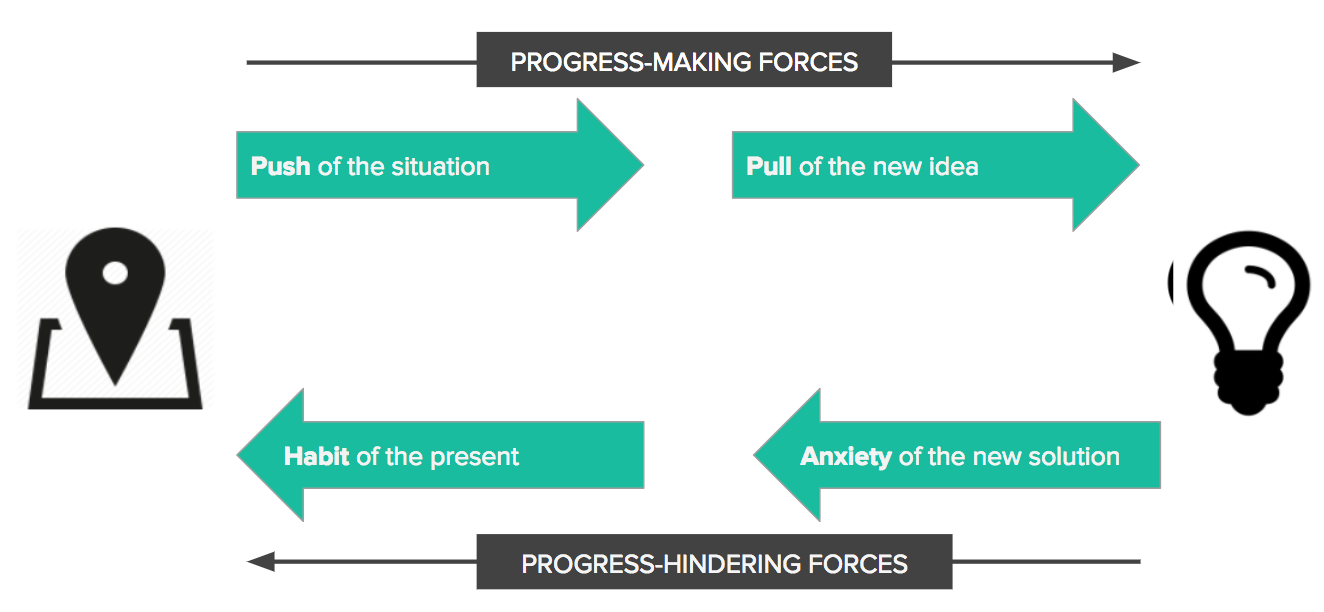
Through the interview, researchers are documenting the forces at play from the point a customer was triggered to make a change, through to his decision and first experience with the new solution.
According to Bob Moestra, ?Any struggling moment is the seed for innovation.? Check the interview or transcript to hear him speak more about the ?following the energy? and identifying user dimensions.
Clay Christensen also dedicated significant time in his book Competing Against Luck to talk about these forces. He claims that ?Consumers can?t articulate what they want. And even when they do, their actions may tell a different story?. He recommends focusing on what customers do; ?in order to hire your new solution, by definition customers must fire some current compensatory behavior or suboptimal solution.?
Author and LeanStack Founder Ash Maurya has also introduced a related ?Customer Forces Canvas? to assist innovators in capturing their learnings from customer interviews.
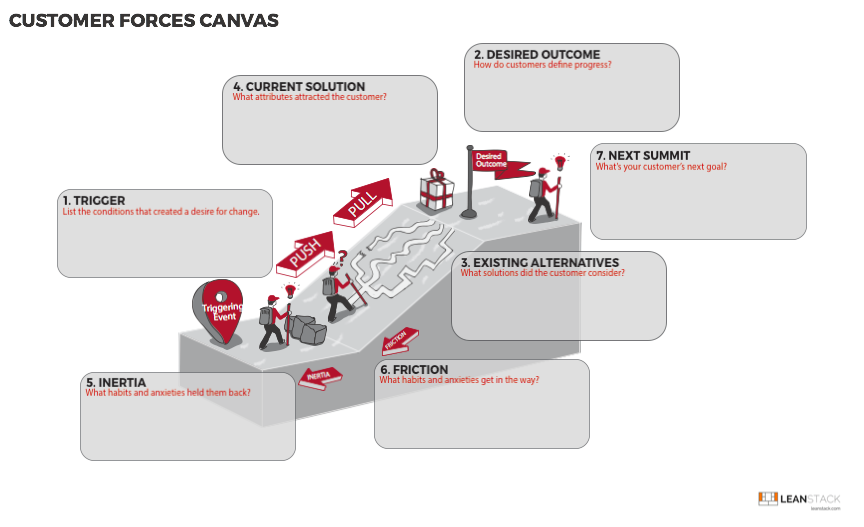
One thing that?s worth noting in the description of the Four Forces diagram: ?when a consumer seeks to make progress (by purchasing a product or service).? This approach and tool is applied in response to an action by our customer. He?s recently switched products. We use this to signal dissatisfaction, and use this as an anchor around which the insights gathering is conducted.
This can be very effective when that?s the behavior we?re trying to model in other customers, but it also severely limits the scope of our research and application of learnings.
Segmenting Your Market
Jobs to be Done practitioners all agree that demographic-based personas are a poor way to segment a market. Instead, the customers? Job to be Done should be considered.
Christensen devotes a fair amount of time in The Innovator?s Solution to discussing market segmentation. Specifically, he introduces what he calls ?circumstance-based segmentation.?
In each case, it?s not enough to simply segment customers by their Jobs to be Done and go after each of them with equal vigor. Additional dimensions should also be considered. In the case of ODI these are the Desired Outcome Statements, in non-ODI projects other user Dimensions are likely to have surfaced through the course of the interview.
Identifying the Opportunity
Christensen recommends focusing on non-consumers; stating that ?competing against non-consumption often offers the biggest source of growth in a world of one-size-fits-all products that do no jobs satisfactorily?. He advises focusing efforts on those potential consumers who are trying to get a job done but are unable to accomplish it because current solutions are too expensive or too complicated. It?s important to note that these aren?t people who don?t have this job, but rather those who are getting it done in an inconvenient, unsatisfying or expensive way.
The ODI process appears to address this by generating an ?Opportunity Score? ? the degree to which a specific outcome or related or emotional job is under- or over-served.
The Switch interview technique runs the risk of missing key insights about non-consumers since it explicitly focuses on engaging with those who have hired a solution.
While there?s no (publicly available) follow-on activity to turn insights from Switch interviews into strategic direction, the ?Help Wanted? section described in the Situation Case Summary listed above may provide a foundation of qualitative information to start from.
 Jobs to be Done is Just the Beginning
Jobs to be Done is Just the Beginning
In this post, you?ve learned how about understanding Jobs to be Done can change how you design, market and sell products to your customers.
We focused primarily on the early stages of uncovering the progress your customer is trying to make and his struggles to do so.
But this is just the foundation for the strategic decisions and tactics your team must take on to benefit from the power of Jobs to be Done theory.
Outcome Driven Innovation Process
The ODI process includes the identifying of unmet needs as but one step along a much more comprehensive process. Proponents of the approach claim that the insights gathered and the corresponding strategy can serve as a roadmap for years. Services include not only research but also marketing strategy, innovation strategy, and pricing and positioning.
 Strategyn?s Outcome Driven Innovation Process
Strategyn?s Outcome Driven Innovation Process
Applying Jobs to be Done in a Portfolio Strategy
Developing an understanding of customers? Jobs to be Done can also serve to drive a product portfolio strategy. This may involve either developing complementary products that help a customer get their entire Job Done better, or competing products that appeal to over- or under-served cutomers.
And there you go ? an overview of some of the nuances between the different methodologies of bringing Jobs to be Done theory into practice.
This post was intentionally non-prescriptive. Your own circumstances and capabilities will lead you to the solution that?s best for you. As always, I welcome questions, comments and corrections to ensure this information is helpful.


